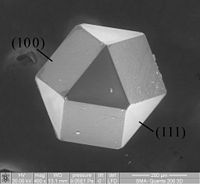
Photo from wikipedia
The development of reliable and flexible machine learning based interatomic potentials (ML-IPs) is becoming increasingly important in studying the physical properties of complex condensed matter systems. Besides the structure descriptor… Click to show full abstract
The development of reliable and flexible machine learning based interatomic potentials (ML-IPs) is becoming increasingly important in studying the physical properties of complex condensed matter systems. Besides the structure descriptor model for total energy decomposition, the trial-and-error approach used in the design of the training dataset makes the ML-IP hardly improvable and reliable for modeling materials with chemical bond hierarchy. In this work, a dual adaptive sampling (DAS) method with an on the fly ambiguity threshold was developed to automatically generate an effective training dataset covering a wide temperature range or a wide spectrum of thermodynamic conditions. The DAS method consists of an inner loop for exploring the local configuration space and an outer loop for covering a wide temperature range. We validated the developed DAS method by simulating thermal transport of complex materials. The simulation results show that even with a substantially small dataset, our approach not only accurately reproduces the energies and forces but also predicts reliably effective high-order force constants to at least fourth order. The lattice thermal conductivity and its temperature dependence were evaluated using the Green-Kubo simulations with ML-IP for $\mathrm{Co}{\mathrm{Sb}}_{3}$ with up to third-order phonon scattering, and those for ${\mathrm{Mg}}_{3}{\mathrm{Sb}}_{2}$ with up to fourth-order phonon scattering, and all show good agreements with experiments. Our work provides an avenue to effectively construct a training dataset for ML-IP of complex materials with chemical bond hierarchy.
Journal Title: Physical Review B
Year Published: 2021
Link to full text (if available)
Share on Social Media: Sign Up to like & get
recommendations!